Shiguo Lian
Fuzzy Reasoning Chain (FRC): An Innovative Reasoning Framework from Fuzziness to Clarity
Sep 26, 2025Abstract:With the rapid advancement of large language models (LLMs), natural language processing (NLP) has achieved remarkable progress. Nonetheless, significant challenges remain in handling texts with ambiguity, polysemy, or uncertainty. We introduce the Fuzzy Reasoning Chain (FRC) framework, which integrates LLM semantic priors with continuous fuzzy membership degrees, creating an explicit interaction between probability-based reasoning and fuzzy membership reasoning. This transition allows ambiguous inputs to be gradually transformed into clear and interpretable decisions while capturing conflicting or uncertain signals that traditional probability-based methods cannot. We validate FRC on sentiment analysis tasks, where both theoretical analysis and empirical results show that it ensures stable reasoning and facilitates knowledge transfer across different model scales. These findings indicate that FRC provides a general mechanism for managing subtle and ambiguous expressions with improved interpretability and robustness.
Hierarchical Deep Fusion Framework for Multi-dimensional Facial Forgery Detection -- The 2024 Global Deepfake Image Detection Challenge
Sep 16, 2025Abstract:The proliferation of sophisticated deepfake technology poses significant challenges to digital security and authenticity. Detecting these forgeries, especially across a wide spectrum of manipulation techniques, requires robust and generalized models. This paper introduces the Hierarchical Deep Fusion Framework (HDFF), an ensemble-based deep learning architecture designed for high-performance facial forgery detection. Our framework integrates four diverse pre-trained sub-models, Swin-MLP, CoAtNet, EfficientNetV2, and DaViT, which are meticulously fine-tuned through a multi-stage process on the MultiFFDI dataset. By concatenating the feature representations from these specialized models and training a final classifier layer, HDFF effectively leverages their collective strengths. This approach achieved a final score of 0.96852 on the competition's private leaderboard, securing the 20th position out of 184 teams, demonstrating the efficacy of hierarchical fusion for complex image classification tasks.
SLearnLLM: A Self-Learning Framework for Efficient Domain-Specific Adaptation of Large Language Models
May 23, 2025Abstract:When using supervised fine-tuning (SFT) to adapt large language models (LLMs) to specific domains, a significant challenge arises: should we use the entire SFT dataset for fine-tuning? Common practice often involves fine-tuning directly on the entire dataset due to limited information on the LLM's past training data. However, if the SFT dataset largely overlaps with the model's existing knowledge, the performance gains are minimal, leading to wasted computational resources. Identifying the unknown knowledge within the SFT dataset and using it to fine-tune the model could substantially improve the training efficiency. To address this challenge, we propose a self-learning framework for LLMs inspired by human learning pattern. This framework takes a fine-tuning (SFT) dataset in a specific domain as input. First, the LLMs answer the questions in the SFT dataset. The LLMs then objectively grade the responses and filter out the incorrectly answered QA pairs. Finally, we fine-tune the LLMs based on this filtered QA set. Experimental results in the fields of agriculture and medicine demonstrate that our method substantially reduces training time while achieving comparable improvements to those attained with full dataset fine-tuning. By concentrating on the unknown knowledge within the SFT dataset, our approach enhances the efficiency of fine-tuning LLMs.
Quantitative Analysis of Performance Drop in DeepSeek Model Quantization
May 05, 2025Abstract:Recently, there is a high demand for deploying DeepSeek-R1 and V3 locally, possibly because the official service often suffers from being busy and some organizations have data privacy concerns. While single-machine deployment offers infrastructure simplicity, the models' 671B FP8 parameter configuration exceeds the practical memory limits of a standard 8-GPU machine. Quantization is a widely used technique that helps reduce model memory consumption. However, it is unclear what the performance of DeepSeek-R1 and V3 will be after being quantized. This technical report presents the first quantitative evaluation of multi-bitwidth quantization across the complete DeepSeek model spectrum. Key findings reveal that 4-bit quantization maintains little performance degradation versus FP8 while enabling single-machine deployment on standard NVIDIA GPU devices. We further propose DQ3_K_M, a dynamic 3-bit quantization method that significantly outperforms traditional Q3_K_M variant on various benchmarks, which is also comparable with 4-bit quantization (Q4_K_M) approach in most tasks. Moreover, DQ3_K_M supports single-machine deployment configurations for both NVIDIA H100/A100 and Huawei 910B. Our implementation of DQ3\_K\_M is released at https://github.com/UnicomAI/DeepSeek-Eval, containing optimized 3-bit quantized variants of both DeepSeek-R1 and DeepSeek-V3.
A Large Vision-Language Model based Environment Perception System for Visually Impaired People
Apr 25, 2025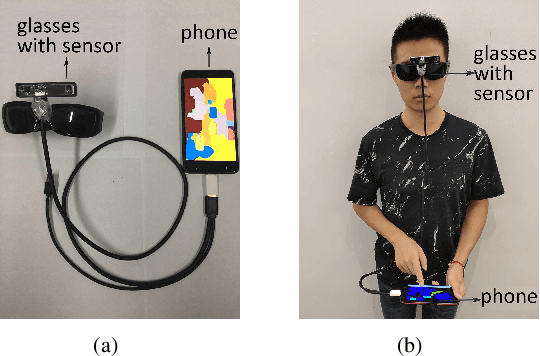

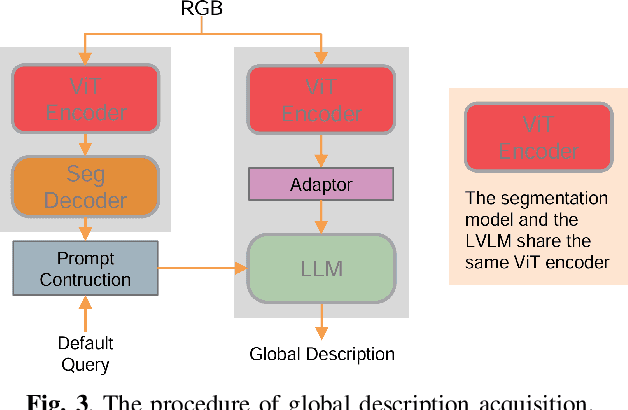
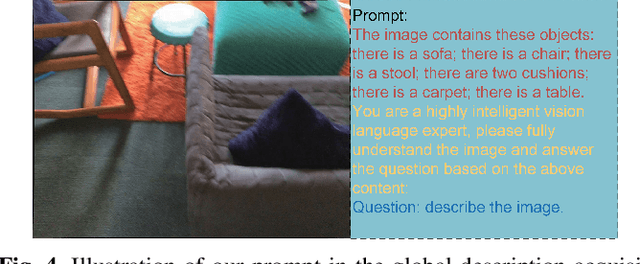
Abstract:It is a challenging task for visually impaired people to perceive their surrounding environment due to the complexity of the natural scenes. Their personal and social activities are thus highly limited. This paper introduces a Large Vision-Language Model(LVLM) based environment perception system which helps them to better understand the surrounding environment, by capturing the current scene they face with a wearable device, and then letting them retrieve the analysis results through the device. The visually impaired people could acquire a global description of the scene by long pressing the screen to activate the LVLM output, retrieve the categories of the objects in the scene resulting from a segmentation model by tapping or swiping the screen, and get a detailed description of the objects they are interested in by double-tapping the screen. To help visually impaired people more accurately perceive the world, this paper proposes incorporating the segmentation result of the RGB image as external knowledge into the input of LVLM to reduce the LVLM's hallucination. Technical experiments on POPE, MME and LLaVA-QA90 show that the system could provide a more accurate description of the scene compared to Qwen-VL-Chat, exploratory experiments show that the system helps visually impaired people to perceive the surrounding environment effectively.
Safety Evaluation and Enhancement of DeepSeek Models in Chinese Contexts
Mar 18, 2025Abstract:DeepSeek-R1, renowned for its exceptional reasoning capabilities and open-source strategy, is significantly influencing the global artificial intelligence landscape. However, it exhibits notable safety shortcomings. Recent research conducted by Robust Intelligence, a subsidiary of Cisco, in collaboration with the University of Pennsylvania, revealed that DeepSeek-R1 achieves a 100\% attack success rate when processing harmful prompts. Furthermore, multiple security firms and research institutions have identified critical security vulnerabilities within the model. Although China Unicom has uncovered safety vulnerabilities of R1 in Chinese contexts, the safety capabilities of the remaining distilled models in the R1 series have not yet been comprehensively evaluated. To address this gap, this study utilizes the comprehensive Chinese safety benchmark CHiSafetyBench to conduct an in-depth safety evaluation of the DeepSeek-R1 series distilled models. The objective is to assess the safety capabilities of these models in Chinese contexts both before and after distillation, and to further elucidate the adverse effects of distillation on model safety. Building on these findings, we implement targeted safety enhancements for six distilled models. Evaluation results indicate that the enhanced models achieve significant improvements in safety while maintaining reasoning capabilities without notable degradation. We open-source the safety-enhanced models at https://github.com/UnicomAI/DeepSeek-R1-Distill-Safe/tree/main to serve as a valuable resource for future research and optimization of DeepSeek models.
A Multimodal Benchmark Dataset and Model for Crop Disease Diagnosis
Mar 10, 2025Abstract:While conversational generative AI has shown considerable potential in enhancing decision-making for agricultural professionals, its exploration has predominantly been anchored in text-based interactions. The evolution of multimodal conversational AI, leveraging vast amounts of image-text data from diverse sources, marks a significant stride forward. However, the application of such advanced vision-language models in the agricultural domain, particularly for crop disease diagnosis, remains underexplored. In this work, we present the crop disease domain multimodal (CDDM) dataset, a pioneering resource designed to advance the field of agricultural research through the application of multimodal learning techniques. The dataset comprises 137,000 images of various crop diseases, accompanied by 1 million question-answer pairs that span a broad spectrum of agricultural knowledge, from disease identification to management practices. By integrating visual and textual data, CDDM facilitates the development of sophisticated question-answering systems capable of providing precise, useful advice to farmers and agricultural professionals. We demonstrate the utility of the dataset by finetuning state-of-the-art multimodal models, showcasing significant improvements in crop disease diagnosis. Specifically, we employed a novel finetuning strategy that utilizes low-rank adaptation (LoRA) to finetune the visual encoder, adapter and language model simultaneously. Our contributions include not only the dataset but also a finetuning strategy and a benchmark to stimulate further research in agricultural technology, aiming to bridge the gap between advanced AI techniques and practical agricultural applications. The dataset is available at https: //github.com/UnicomAI/UnicomBenchmark/tree/main/CDDMBench.
Optimizing for the Shortest Path in Denoising Diffusion Model
Mar 06, 2025Abstract:In this research, we propose a novel denoising diffusion model based on shortest-path modeling that optimizes residual propagation to enhance both denoising efficiency and quality. Drawing on Denoising Diffusion Implicit Models (DDIM) and insights from graph theory, our model, termed the Shortest Path Diffusion Model (ShortDF), treats the denoising process as a shortest-path problem aimed at minimizing reconstruction error. By optimizing the initial residuals, we improve the efficiency of the reverse diffusion process and the quality of the generated samples. Extensive experiments on multiple standard benchmarks demonstrate that ShortDF significantly reduces diffusion time (or steps) while enhancing the visual fidelity of generated samples compared to prior arts. This work, we suppose, paves the way for interactive diffusion-based applications and establishes a foundation for rapid data generation. Code is available at https://github.com/UnicomAI/ShortDF
DAST: Difficulty-Adaptive Slow-Thinking for Large Reasoning Models
Mar 06, 2025Abstract:Recent advancements in slow-thinking reasoning models have shown exceptional performance in complex reasoning tasks. However, these models often exhibit overthinking-generating redundant reasoning steps for simple problems, leading to excessive computational resource usage. While current mitigation strategies uniformly reduce reasoning tokens, they risk degrading performance on challenging tasks that require extended reasoning. This paper introduces Difficulty-Adaptive Slow-Thinking (DAST), a novel framework that enables models to autonomously adjust the length of Chain-of-Thought(CoT) based on problem difficulty. We first propose a Token Length Budget (TLB) metric to quantify difficulty, then leveraging length-aware reward shaping and length preference optimization to implement DAST. DAST penalizes overlong responses for simple tasks while incentivizing sufficient reasoning for complex problems. Experiments on diverse datasets and model scales demonstrate that DAST effectively mitigates overthinking (reducing token usage by over 30\% on average) while preserving reasoning accuracy on complex problems.
Mining Glitch Tokens in Large Language Models via Gradient-based Discrete Optimization
Oct 19, 2024
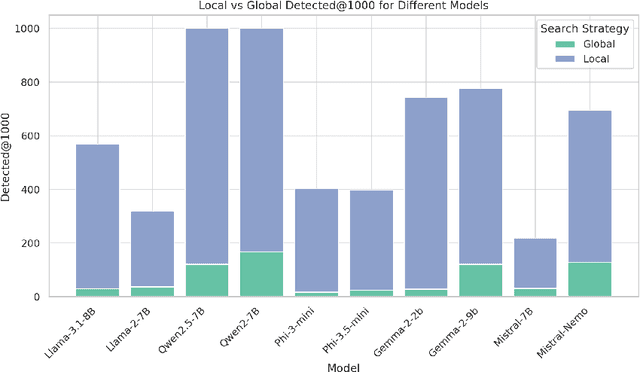
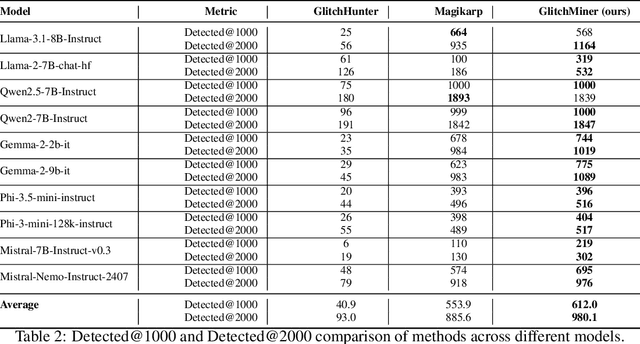

Abstract:Glitch tokens in Large Language Models (LLMs) can trigger unpredictable behaviors, compromising model reliability and safety. Existing detection methods often rely on manual observation to infer the prior distribution of glitch tokens, which is inefficient and lacks adaptability across diverse model architectures. To address these limitations, we introduce GlitchMiner, a gradient-based discrete optimization framework designed for efficient glitch token detection in LLMs. GlitchMiner leverages an entropy-based loss function to quantify the uncertainty in model predictions and integrates first-order Taylor approximation with a local search strategy to effectively explore the token space. Our evaluation across various mainstream LLM architectures demonstrates that GlitchMiner surpasses existing methods in both detection precision and adaptability. In comparison to the previous state-of-the-art, GlitchMiner achieves an average improvement of 19.07% in precision@1000 for glitch token detection. By enabling efficient detection of glitch tokens, GlitchMiner provides a valuable tool for assessing and mitigating potential vulnerabilities in LLMs, contributing to their overall security.
 Add to Chrome
Add to Chrome Add to Firefox
Add to Firefox Add to Edge
Add to Edge